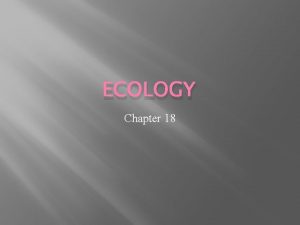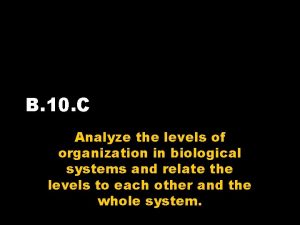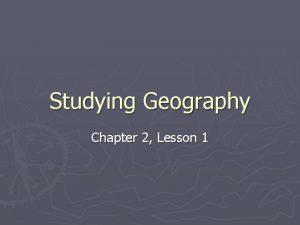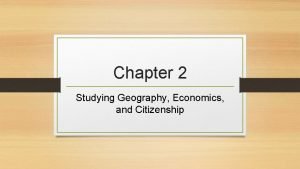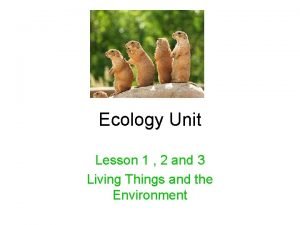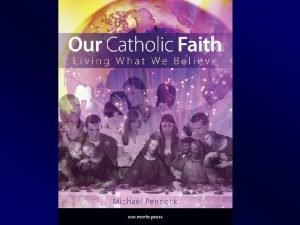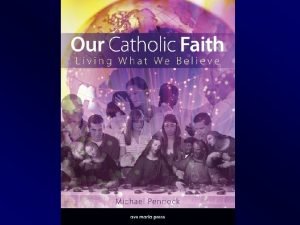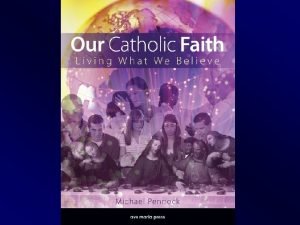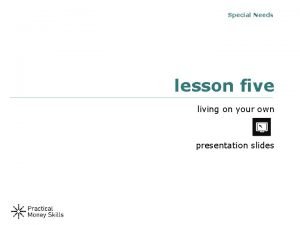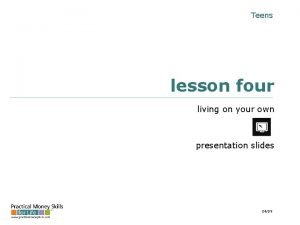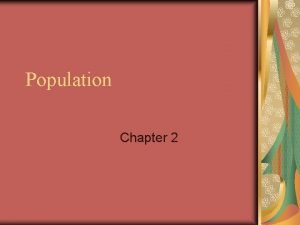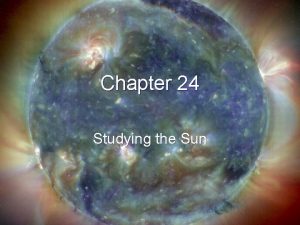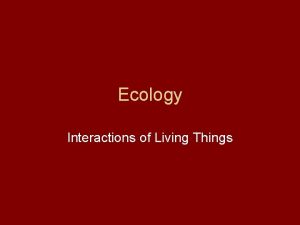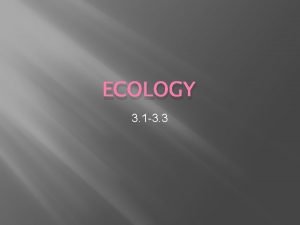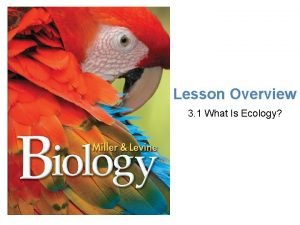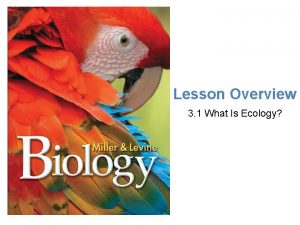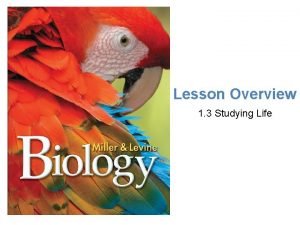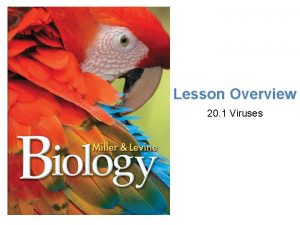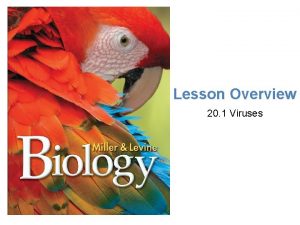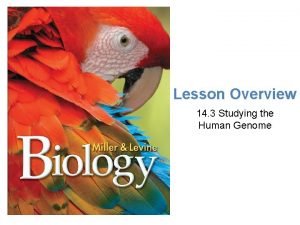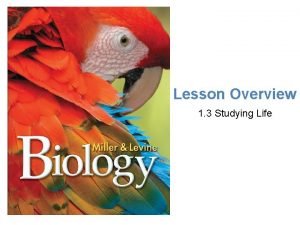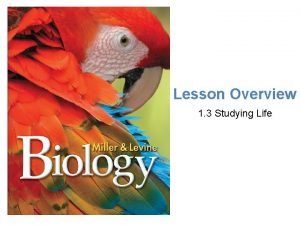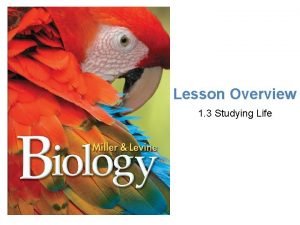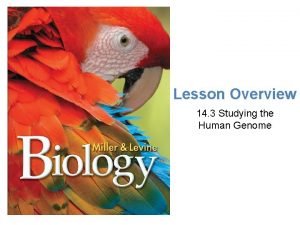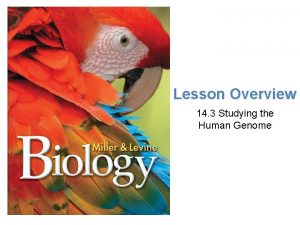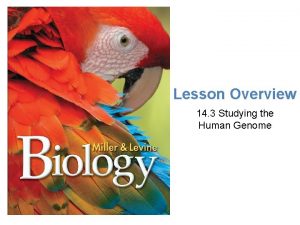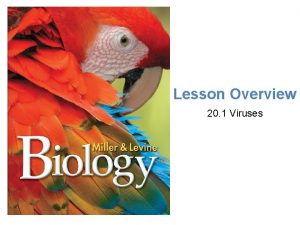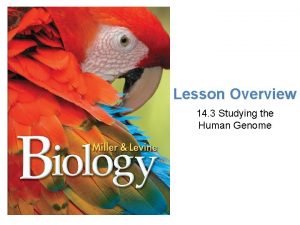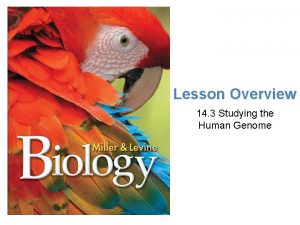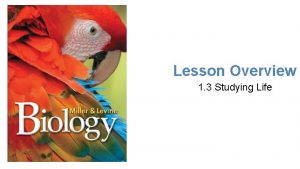Lesson Overview What is Ecology Studying Our Living






































- Slides: 38

Lesson Overview What is Ecology? Studying Our Living Planet The biosphere consists of all life on Earth and all parts of the Earth in which life exists, including land, water, and the atmosphere. The biosphere extends from about 8 km above Earth’s surface to as far as 11 km below the surface of the ocean.

Lesson Overview What is Ecology? The Science of Ecology is the scientific study of interactions among and between organisms and their physical environment. Interactions within the biosphere produce a web of interdependence between organisms and the environments in which they live.

Lesson Overview What is Ecology? The Science of Ecology Organisms respond to their environments and can change their environments, producing an ever-changing biosphere.

Lesson Overview What is Ecology? Ecology and Economics is concerned with interactions based on money. Economics and ecology share the same word root. Indeed, human economics and ecology are linked. Humans live within the biosphere and depend on ecological processes to provide such essentials as food and drinkable water that can be bought and sold for money.

Lesson Overview What is Ecology? Levels of Organization Ecological studies may focus on levels of organization that include the following: Individual organism

Lesson Overview What is Ecology? Levels of Organization Ecological studies may focus on levels of organization that include the following: Population—a group of individuals that belong to the same species and live in the same area Community—an assemblage of different populations that live together in a defined area Ecosystem—all the organisms that live in a place, together with their physical environment

Lesson Overview What is Ecology? Levels of Organization Ecological studies may focus on levels of organization that include the following: Biome—a group of ecosystems that share similar climates and typical organisms Biosphere—our entire planet, with all its organisms and physical environments

Lesson Overview What is Ecology? Biotic Factors A biotic factor is any living part of the environment with which an organism might interact, including animals, plants, mushrooms and bacteria. Biotic factors relating to a bullfrog might include algae it eats as a tadpole, the herons that eat bullfrogs, and other species competing for food or space.

Lesson Overview What is Ecology? Abiotic Factors An abiotic factor is any nonliving part of the environment, such as sunlight, heat, precipitation, humidity, wind or water currents, soil type, etc. For example, a bullfrog could be affected by abiotic factors such as water availability, temperature, and humidity.

Lesson Overview What is Ecology? Ecological Methods What methods are used in ecological studies?

Lesson Overview What is Ecology? Ecological Methods What methods are used in ecological studies? Regardless of their tools, modern ecologists use three methods in their work: observation, experimentation, and modeling. Each of these approaches relies on scientific methodology to guide inquiry. Observation is often the first step in asking ecological questions. Questions may form the first step in designing experiments and models. Many ecological events occur over such long periods of time or over such large distances that they are difficult to study directly. Ecologists make models to help them understand these phenomena.

Lesson Overview What is Ecology? Primary Producers What are primary producers? Primary producers are the first producers of energy-rich compounds that are later used by other organisms. Organisms need energy for growth, reproduction, and metabolic processes. No organism can create energy—organisms can only use energy from other sources. For most life on Earth, sunlight is the ultimate energy source. For some organisms, however, chemical energy stored in inorganic chemical compounds serves as the ultimate energy source for life processes.

Lesson Overview What is Ecology? Primary Producers Plants, algae, and certain bacteria can capture energy from sunlight or chemicals and convert it into forms that living cells can use. These organisms are called autotrophs. Autotrophs are also called primary producers.

Lesson Overview What is Ecology? Energy From the Sun The best-known and most common primary producers harness solar energy through the process of photosynthesis.

Lesson Overview What is Ecology? Energy From the Sun Photosynthesis captures light energy and uses it to power chemical reactions that convert carbon dioxide and water into oxygen and energyrich carbohydrates. This process adds oxygen to the atmosphere and removes carbon dioxide.

Lesson Overview What is Ecology? Energy From the Sun Plants are the main photosynthetic producers on land. Algae fill that role in freshwater ecosystems and the sunlit upper ocean. Photosynthetic bacteria, most commonly cyanobacteria, are important primary producers in tidal flats and salt marshes.

Lesson Overview What is Ecology? Life Without Light Deep-sea ecosystems depend on primary producers that harness chemical energy from inorganic molecules such as hydrogen sulfide. The use of chemical energy to produce carbohydrates is called chemosynthesis.

Lesson Overview What is Ecology? Consumers How do consumers obtain energy and nutrients? Organisms that rely on other organisms for energy and nutrients are called consumers.

Lesson Overview What is Ecology? Consumers Organisms that must acquire energy from other organisms by ingesting in some way are known as heterotrophs. Heterotrophs are also called consumers. Detritivore

Lesson Overview What is Ecology? Types of Consumers Carnivores kill and eat other animals, and include snakes, dogs, cats, and this giant river otter. Scavengers, like a king vulture, are animals that consume the carcasses of other animals that have been killed by predators or have died of other causes. Decomposers, such as bacteria and fungi, feed by chemically breaking down organic matter. The decay caused by decomposers is part of the process that produces detritus—small pieces of dead and decaying plant and animal remains. Herbivores, such as a military macaw, obtain energy and nutrients by eating plant leaves, roots, seeds, or fruits. Common herbivores include cows, caterpillars, and deer. Omnivores are animals whose diets naturally include a variety of different foods that usually include both plants and animals. Humans, bears, and pigs are omnivores.

Lesson Overview What is Ecology? THINK ABOUT IT What happens to energy stored in body tissues when one organism eats another? Energy moves from the “eaten” to the “eater. ” Where it goes from there depends on who eats whom!

Lesson Overview What is Ecology? Food Chains and Food Webs How does energy flow through ecosystems? Energy flows through an ecosystem in a one-way stream, from primary producers to various consumers.

Lesson Overview What is Ecology? Food Chains A food chain is a series of steps in which organisms transfer energy by eating and being eaten. Food chains can vary in length. An example from the Everglades is shown. In some aquatic food chains, such as the example shown, primary producers are a mixture of floating algae called phytoplankton and attached algae. These producers are eaten by small fishes, such as flagfish.

Lesson Overview What is Ecology? Food Webs In most ecosystems, feeding relationships are much more complicated than the relationships described in a single, simple chain because many animals eat more than one kind of food. Ecologists call this network of feeding interactions a food web. An example of a food web in the Everglades is shown.

Lesson Overview What is Ecology? Decomposers and Detritivores in Food Webs Most producers die without being eaten. In the detritus pathway, decomposers convert that dead material to detritus, which is eaten by detritivores, such as crayfish, grass shrimp, and worms. Pig frogs, killifish, and other fishes eat the detritivores.

Lesson Overview What is Ecology? Food Webs and Disturbance When disturbances to food webs happen, their effects can be dramatic. For example, all of the animals in this food web depend directly or indirectly on shrimplike animals called krill. Krill are one example of small, swimming animals called zooplankton.

Lesson Overview What is Ecology? Trophic Levels and Ecological Pyramids What do the three types of ecological pyramids illustrate? Pyramids of energy show the relative amount of energy available at each trophic level. A pyramid of biomass illustrates the relative amount of living organic matter at each trophic level. What do the three types of ecological pyramids illustrate? A pyramid of numbers shows the relative number of individual organisms at each trophic level in an ecosystem.

Lesson Overview What is Ecology? Trophic Levels and Ecological Pyramids Each step in a food chain or food web is called a trophic level. Primary producers always make up the first trophic level. Various consumers occupy every other level. Some examples are shown.

Lesson Overview What is Ecology? Trophic Levels and Ecological Pyramids Ecological pyramids show the relative amount of energy or matter contained within each trophic level in a given food chain or food web. There are three different types of ecological pyramids: pyramids of energy, pyramids of biomass, and pyramids of numbers.

Lesson Overview What is Ecology? Pyramids of Energy There is theoretically no limit to the number of trophic levels in a food web or the number of organisms that live on each level. However, only a small portion of the energy that passes through any given trophic level is ultimately stored in the bodies of organisms at the next level.

Lesson Overview What is Ecology? Pyramids of Energy Organisms expend much of the energy they acquire on life processes, such as respiration, movement, growth, and reproduction. Most of the remaining energy is released into the environment as heat— a byproduct of these activities.

Lesson Overview What is Ecology? Pyramids of Energy Pyramids of energy show the relative amount of energy available at each trophic level.

Lesson Overview What is Ecology? Pyramids of Energy On average, about 10 percent of the energy available within one trophic level is transferred to the next trophic level. The more levels that exist between a producer and a consumer, the smaller the percentage of the original energy from producers that is available to that consumer.

Lesson Overview What is Ecology? Pyramids of Biomass and Numbers The total amount of living tissue within a given trophic level is called its biomass. The amount of biomass a given trophic level can support is determined, in part, by the amount of energy available.

Lesson Overview What is Ecology? Pyramids of Biomass and Numbers A pyramid of biomass illustrates the relative amount of living organic matter at each trophic level. Typically, the greatest biomass is at the base of the pyramid, as is seen in the field ecosystem modeled here.

Lesson Overview What is Ecology? Pyramids of Biomass and Numbers A pyramid of numbers shows the relative number of individual organisms at each trophic level in an ecosystem.

Lesson Overview What is Ecology? Pyramids of Biomass and Numbers In most ecosystems, the shape of the pyramid of numbers is similar to the shape of the pyramid of biomass for the same ecosystem, with the numbers of individuals on each level decreasing from the level below it.

Lesson Overview What is Ecology? Pyramids of Biomass and Numbers In some cases, however, consumers are much smaller than organisms they feed upon. Thousands of insects may graze on a single tree, for example. The tree has a lot of biomass, but represents only one organism. In such cases, the pyramid of numbers may be turned upside down, but the pyramid of biomass usually still has the normal orientation.
 Studying our living planet
Studying our living planet A student is studying the ecology of a playa lake
A student is studying the ecology of a playa lake A student is studying the ecology of a playa lake
A student is studying the ecology of a playa lake Lesson 1 studying geography
Lesson 1 studying geography Chapter 2 lesson 1 studying geography
Chapter 2 lesson 1 studying geography Lesson 1 studying geography
Lesson 1 studying geography Difference between living and non living organisms
Difference between living and non living organisms Is mold living or nonliving
Is mold living or nonliving Living non living dead
Living non living dead Mitochondria information
Mitochondria information Lesson 1 introduction to ecology answer key
Lesson 1 introduction to ecology answer key Our catholic faith living what we believe answers
Our catholic faith living what we believe answers Our catholic faith living what we believe
Our catholic faith living what we believe Our catholic faith living what we believe
Our catholic faith living what we believe Chapter 9 lesson 2 photosynthesis an overview
Chapter 9 lesson 2 photosynthesis an overview Lesson overview
Lesson overview Thinking affects our language, which then affects our:
Thinking affects our language, which then affects our: Our census our future
Our census our future Bernadette farrell christ be our light
Bernadette farrell christ be our light Marcus aurelius our life is what our thoughts make it
Marcus aurelius our life is what our thoughts make it We bow our hearts we bend our knees
We bow our hearts we bend our knees Our census our future
Our census our future Our life is what our thoughts make it
Our life is what our thoughts make it Money madness meaning
Money madness meaning Awareness of ourselves and our environment is
Awareness of ourselves and our environment is Our awareness of ourselves and our environment.
Our awareness of ourselves and our environment. God our father christ our brother
God our father christ our brother Our future is in our hands quotes
Our future is in our hands quotes Our awareness of ourselves and our environment.
Our awareness of ourselves and our environment. Our awareness of ourselves and our environment
Our awareness of ourselves and our environment Lesson four living on your own
Lesson four living on your own Lesson four living on your own
Lesson four living on your own Classifying living things lesson 1 answer key
Classifying living things lesson 1 answer key Researchers who are studying a new shampoo formula
Researchers who are studying a new shampoo formula Importance of studying population
Importance of studying population Job ranking method example
Job ranking method example Rakats in jummah
Rakats in jummah Studying in sweden as an eu citizen
Studying in sweden as an eu citizen Chapter 24 studying the sun
Chapter 24 studying the sun
